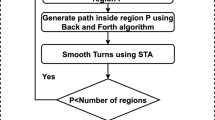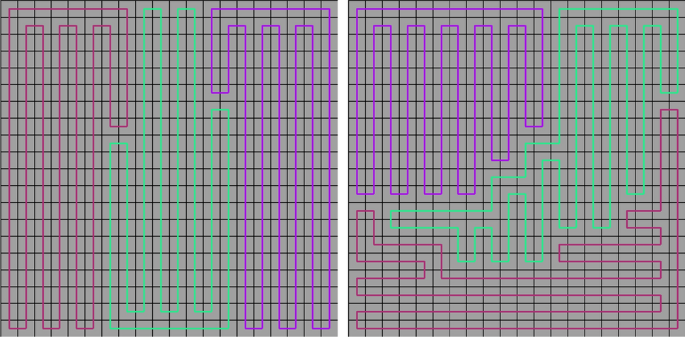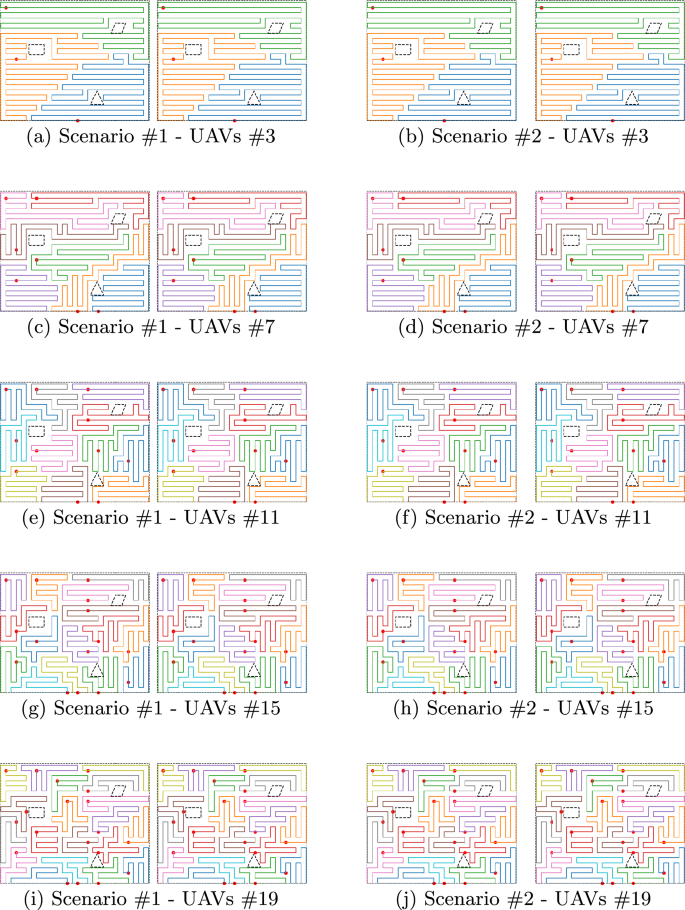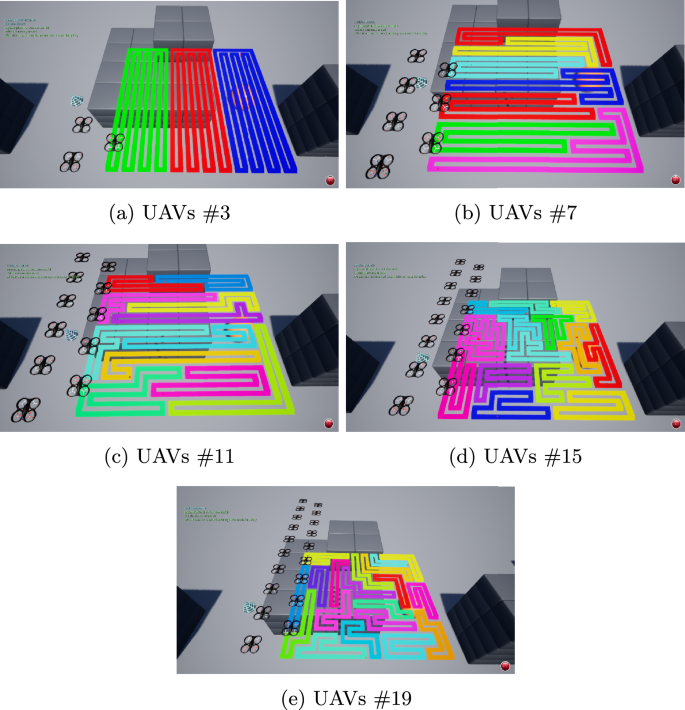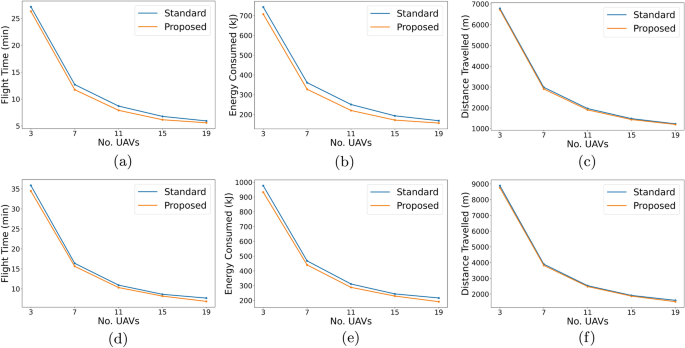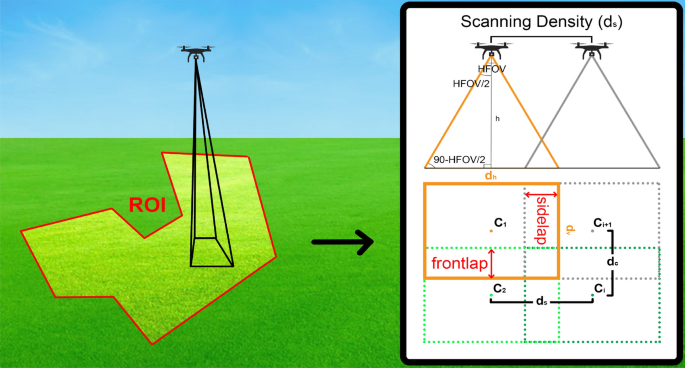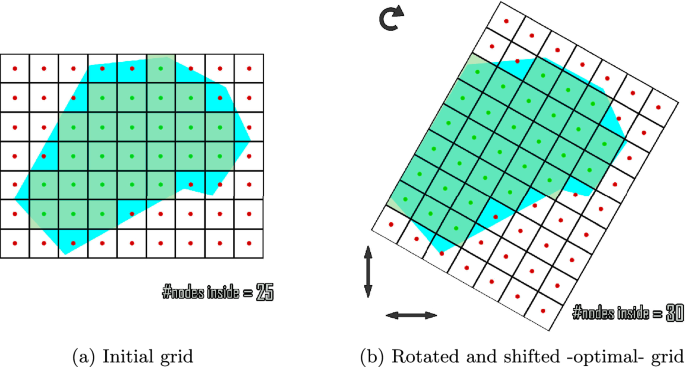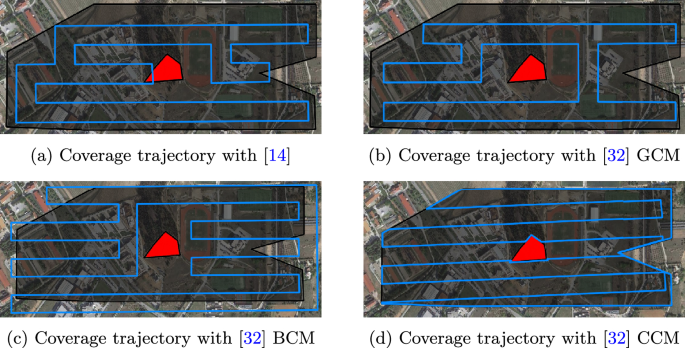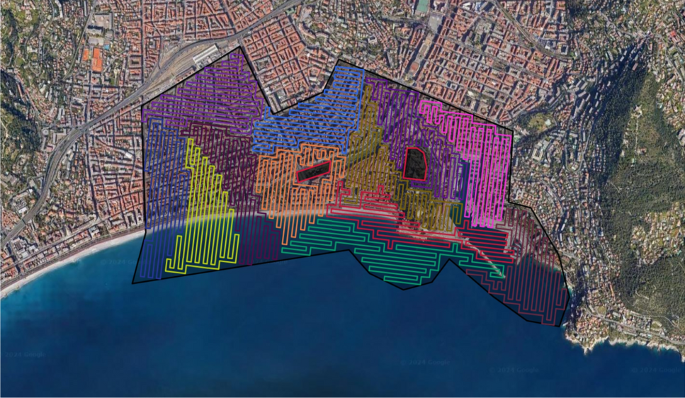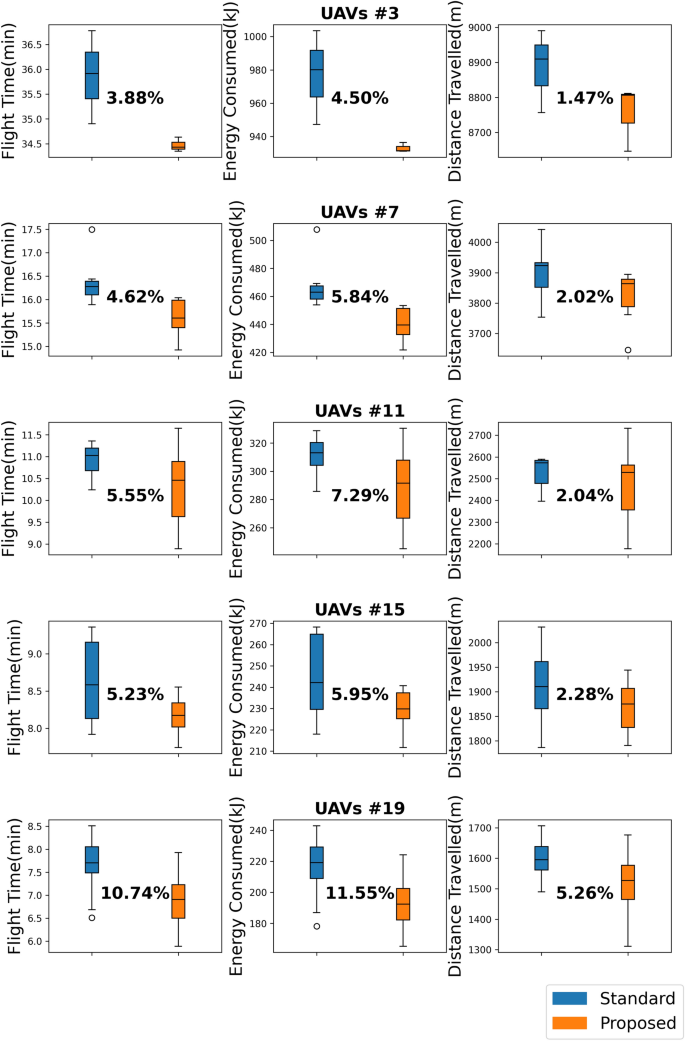Abstract
This paper focuses on Coverage Path Planning (CPP) methodologies, particularly in the context of multi-robot missions, to efficiently cover user-defined Regions of Interest (ROIs) using groups of UAVs, while emphasizing on the reduction of energy consumption and mission duration. Optimizing the efficiency of multi-robot CPP missions involves addressing critical factors such as path length, the number of turns, re-visitations, and launch positions. Achieving these goals, particularly in complex and concave ROIs with No-Go Zones, is a challenging task. This work introduces a novel approach to address these challenges, emphasizing the selection of launch points for UAVs. By optimizing launch points, the mission’s energy and time efficiency are significantly enhanced, leading to more efficient coverage of the selected ROIs. To further support our research and foster further exploration on this topic, we provide the open-source implementation of our algorithm and our evaluation mechanisms.
Similar content being viewed by others
Avoid common mistakes on your manuscript.
1 Introduction
Nowadays, a wide range of enterprise domains take advantage of the remote sensing capabilities offered by Unmanned Air Vehicles (UAVs) to collect data for various purposes. The scope of applications that utilize UAVs for data collection includes precision agriculture (Maes and Steppe 2019; Krestenitis et al. 2024; Karatzinis et al. 2020; Raptis et al. 2023), infrastructure inspection (Máthé and Buşoniu 2015; Shakhatreh et al. 2019), exploration (Cesare et al. 2015; Renzaglia et al. 2020) and monitoring (Koutras et al. 2020; Kapoutsis et al. 2019). To efficiently collect data in an automated way, Coverage Path Planning (CPP) methodologies (Galceran and Carreras 2013; Cabreira et al. 2019) are commonly utilized to calculate paths for the UAVs to cover a user-defined Region of Interest (ROI) completely. The utilization of multiple UAVs to cover a ROI can introduce significant benefits in terms of the area that can be covered during the nominal operational duration of the vehicles used, or the amount of time needed to cover a certain ROI, two factors that may be critical in certain types of operations, such as the search and rescue missions. This kind of methodology is known as multi-robot Coverage Path Planning (mCPP) (Almadhoun et al. 2019).
Using multiple unmanned vehicles can greatly decrease the duration required to carry out a specific mission. However, in order to fully maximize the potential benefits of unmanned vehicles, an mCPP approach must integrate characteristics that promote overall efficiency in terms of time and energy usage.
The major factors that affect the efficiency of a CPP methodology, are:
-
The length of the path needed to scan a certain ROI,
-
The number of turns introduced in the generated path,
-
The number of re-visitations of specific parts of the ROI demanded to cover it completely, and
-
The distance of the take-off and landing position from the starting and ending points of the path respectively. Cabreira et al. (2019).
Optimizing all of these parameters for energy and time efficiency while ensuring complete coverage is a challenging task, even for methods that only have to manage a single vehicle. The situation becomes even more intricate when attempting to accomplish this task cooperatively with methods that require handling of multiple vehicles simultaneously.
The problem tackled in this work is the design of multi-robot paths that can optimally cover any user-defined ROI, even the most complex-shaped, concave ones, including No-Go-Zones (NGZs) inside of them. A distinct feature of this work is the selection of robots’ launch points by an optimization procedure, in order to further increase the energy and time efficiency of the generated trajectories. This problem is of great importance, especially i) in cases that coverage missions are performed periodically in large areas and ii) in scenarios that completing the mission as quickly as possible is crucial.
In many such cases, the initial configuration of the group does not only correspond to the first waypoints of the missions but also indicates the optimal positions to establish bases (charging/refueling points) for the unmanned vehicles that periodically cover a specific ROI.
Two indicative examples of such missions are optimizing crop yield in precision agriculture and assessing changes in urban infrastructure. In precision agriculture, real-time monitoring of crop health and nutrient levels is crucial for maximizing yield and minimizing resource use. Meanwhile, in urban infrastructure assessment, tracking long-term changes in building structures and city layouts is essential for effective planning and development.
1.1 Contributions
In this project, building upon the foundation established in Apostolidis et al. (2022), we are continuing the research previously conducted by our laboratory, introducing an optimization scheme to search for the optimal initial configuration of UAVs in a way that provides increased operational efficiency.
The base methodology already incorporates a set of features that maximizes the efficiency of the individual paths. In this project, we introduce an optimization procedure that not only reduces complexity in the shapes of the exclusive sub-regions, thereby minimizing the number of turns required in the multi-robot solution, but also enhances energy and time efficiency for the multi-robot solution. At the same time it suggests the ideal points to setup launching/docking stations for long-term coverage operations. This is accomplished by precisely controlling the launch points of each UAV. The efficiency of the proposed scheme is proved through extensive simulated evaluations where the gains are quantified and measured.
As a significant contribution to the research community, we have open-sourced the repositories containing our algorithms and evaluation mechanisms. This initiative is crucial in fostering collaboration, enabling researchers to replicate, validate, and build upon our work, thereby advancing the collective knowledge in this domainFootnote 1.
1.2 Paper outline
The rest of the work is organized as follows: Sect. 2 presents a short literature overview of the relatively recent CPP works that focus on the efficiency of the generated trajectories, Sect. 3 strictly defines the specific problem that this work solves, Sect. 4 describes the methodology followed in an elaborate way, Sect. 5 presents the results of the simulated evaluation of the method and Sect. 6 provides an overview of the research and delves into its results and consequences.
2 Related work
The energy consumption and the operational duration of coverage missions are problems that have attracted the interest of several researchers, resulting in various studies presenting diverse approaches to address these challenges. This sub-section presents some of these works that manage to stand out, either by introducing innovative solutions to these problems or by delivering interesting/promising results.
In Choset and Pignon (1998); Bähnemann et al. (2021), the authors present a path planner for low-altitude terrain coverage in known environments utilizing a single unmanned rotary-wing micro aerial vehicle. The power of the proposed methodology lies in the fact that it can achieve complete coverage of ROIs of any shape and size, which may include a various number of no-fly zones inside it. The introduced approach extends boustrophedon coverage planning by optimizing different sweep combinations to find the optimal sweep path. It can operate using three optimization criteria, that include minimizing time, path length, and the number of turns. While this approach stands out as one of the most effective in terms of complete coverage in demanding ROIs, the strictness of the complete coverage limitation impacts the optimality in terms of time and energy efficiency that can be achieved.
Vandermeulen et al. (2019) presents an approach to solve the mCPP problem, intending to minimize the mission time, with a particular focus on factoring in the impact of the number of turns in the generated paths. To solve this problem, the presented methodology partitions the environment into a set of ranks which are long thin rectangles (having the width of the robot’s coverage tool). These ranks are oriented in a way that minimizes the occurrence of turns. As a next step, multiple traveling salesperson problems (m-TSP) are solved on the set of ranks, that intend to reduce the robots’ mission time. The coverage plan that is generated, according to the authors, provides complete coverage of the ROI. This method is mainly focused on ground vehicles used to vacuum indoor environments. However, it could be easily applied in other coverage missions with minor modifications. It should be noted that the generated paths present intersecting points among different vehicles, introducing increased probability for collisions and unnecessary overlaps, which leads to redundant multiple coverage of certain parts of the ROI, thus decreasing the overall operational efficiency.
In Ramesh et al. (2022), the authors introduce a methodology that tackles the same problem and presents results very similar (at least optically) to Vandermeulen et al. (2019), however, for a single vehicle. As the authors claim, their heuristic method for finding the number of ranks guarantees optimality. As in the previous work, the generated path has an unnecessary overlap to connect the sub-parts of the region, leading to multiple coverage of specific areas and consequently leading to decreased overall efficiency.
Skorobogatov et al. (2021) introduces an open-source solution for splitting areas of any shape for mCPP missions, tailored to UAVs. It assumes certain parameters such as the number of vehicles, the requirements of the area to be covered by each UAV, and, optionally, the initial position of each UAV. The target of the splitting procedure is to maximize the "compactness" of the generated sub-polygons. By adopting the aforementioned approach, the resulting trajectories exhibit a decreased number of turns, leading to a reduction in coverage duration. While this work presents an approach with increased efficiency for the mCPP missions, it possesses two significant disadvantages (also presented in Vandermeulen et al. (2019), but with a more pronounced impact in the context of UAV utilization). The first one is that the generated trajectories overlap and prsent several intersecting points in the marginal regions of the sub-polygons. As already mentioned, this may lead to unnecessary overlapping coverage of various parts of the ROI, thus reducing the overall efficiency. Still, most importantly, the intersecting points increase the risk of collisions among the UAVs, which is considered a major safety issue. In addition to that, due to the back-and-forth pattern used, the initial positions for the UAVs are required to be near the margins of the ROI, significantly limiting the options to establish bases in cases that the coverage missions are required to be performed regularly.
Kapoutsis et al. (2017) investigates an area division approach to decompose a ROI into an as-many-as-the-vehicles number of sub-regions. It proceeds to address the mCPP problem by solving individual single-robot CPP problems, employing the STC algorithm (Gabriely and Rimon 2001) for each sub-region. The presented methodology effectively resolves the mCPP problem in a computationally efficient way. At the same time, it also inherits some features of STC that can lead to increased operational efficiency (e.g., it eliminates the need for backtracking and avoids unnecessary movements that do not contribute to the coverage process).
Gao et al. (2018) uses (Kapoutsis et al. 2017) as a basis and, by utilizing an improved ant colony optimization (ACO) algorithm, it attempts to construct the best-spanning trees to obtain paths with the minimal number of turns, which contributes to minimizing the energy/time consumption. This, combined with the features inherited by STC, leads to a method that presents increased operational efficiency when applied to a single robot. However, due to the complex shapes that the generated sub-regions showcase, the number of turns, and thus the overall efficiency, may not reach its optimal level when multiple vehicles are employed.
Apostolidis et al. (2022) also builts uppon (Kapoutsis et al. 2017) and presents an end-to-end platform for multi-UAV remote sensing coverage missions, focusing on real-life applicability and efficiency. One of the most significant contributions of this work is the optimization procedure introduced to calculate the optimal grid, which maximizes coverage in real-life problems for grid-based methodologies. Furthermore, a turns reduction procedure is applied on the individual STC paths, leading in a substantial decrease in both the number of turns and the overall operational time. This method also inherits the nice-to-have features that STC paths provide; However, as Gao et al. (2018), it also suffers from the complexity of the sub-regions shapes that introduce multiple turns to the paths, when multiple vehicles are deployed.
Finally, Luna et al. (2022) deals with the problem of fast mCPP for UAVs. The presented work is packed to ensure that it is easily usable by first responder. To solve the mCPP problem, three different methods are utilized. Out of them, "POWELL-BINPAT" is the most efficient regarding the mission’s duration. Contrary to the aforementioned works, this methodology ensures that there are no overlapping trajectories in the generated mission’s paths. In addition to that, the authors put forth a solution that involves flying each UAV at different altitudes, from the launching point to the first mission’s waypoint and from the last waypoint back to the ground, to eliminate the risk of collisions and provide safety for multi-UAV operations. However, once again, the paths’ initial points are challenging to control, limiting the possible positions significantly to establish charging points inside the operational area in cases where coverage missions are performed regularly.
Out of the works presented above, Choset and Pignon (1998); Bähnemann et al. (2021); Apostolidis et al. (2022); Luna et al. (2022) are the most mature ones, in terms of real-life operation readiness. All of the works described propose interesting ideas to reduce operational time and energy consumption, however, they also seem to incorporate several disadvantages. Specifically, none of the above works manage to integrate all of the essential features required to achieve optimal operational efficiency in the context of long-term, real-world coverage operations. They do not generate paths with minimized length, reduced number of turns, decreased operational time, and lower energy consumption, both for the single and multi-robot solutions. Moreover, they do not guarantee the safety of vehicles by preventing trajectory intersections and they do not facilitate the placement of launching and docking stations within the region of interest without adding unnecessary distance for vehicles to traverse when reaching the first and returning from the last waypoints.
3 Problem formulation
Let’s consider a Region of Interest (ROI), which may include no-go-zones (NGZs) and obstacles, that needs to be fully covered using a group of UAVs. The objective for this group of UAVs is to work collaboratively in order to achieve complete coverage of the ROI in the shortest possible time, effectively maximizing the utilization of all available resources. For this reason, meticulous path planning for the group during the mCPP mission is essential. Our goal is to generate mCPP trajectories which ensure that each UAV operates efficiently, avoiding collisions with obstacles and staying clear of NGZs. Additionally, the designed trajectories should prioritize efficiency, in terms of both time and operational resources. By carefully optimizing the paths, we not only intend to maximize the coverage of the area of interest, but also make the most effective use of available resources, leading to an effective and resource-efficient mission execution.
The methodology presented in this work, builds upon some previous works from our lab, that have already solved the problems of (i) efficiently representing a region on a grid, taking into consideration the parameters that affect the effectiveness of real-world operations, (ii) task allocation of the overall problem, so that each member of the UAV group can undertake a specific part of the overall ROI to cover, and (iii) generation of trajectories for each of them, to fulfill their objective and cover their exclusive sub-part of the ROI. The following sub-section shortly presents these steps, while more technical details about them can be found in Appendix A.
3.1 ROI representation on grid, task allocation and path planning
Given as input: (i) the user-defined ROI and NGZs, formatted in the WGS84 coordinate system (Cai et al. 2011), (ii) the desired distance between sequential trajectories (scanning density - \(d_s\)), (iii) the number of UAVs, and (iv) their initial positions in the operational area, the following steps take place:
-
The ROI is represented on a grid, with the size of the grid and the length of its cells depending on the \(d_s\). Each cell of the grid acquires a state that can be "Obstacle," "Free Space," or "Launch Point".
-
DARP algorithm (Kapoutsis et al. 2017), using as input the representation of the ROI on grid, runs to generate exclusive sub-regions for each UAV to cover.
-
STC algorithm (Gabriely and Rimon 2001) is utilized to generate coverage trajectories for each UAV to follow, so that it completely covers its operational sub-region.
3.2 Path execution
The UAVs navigate through the designed paths within the ROI, described using intermediate nodes in the grid. The aforementioned paths are defined using the following Equation:
In Eq. 1, \((p_0,..., p_n) \in P\) are the paths that each one of the UAVs will navigate through, \((n_0^0,n_0^1,..., n_0^l)\) and \((n_n^0,n_n^1..., n_n^k)\) are the intermediate nodes that the UAVs will pass through to execute their assigned path, with \(l, k\) set equally due to the equal distribution of coverage areas among UAVs. Therefore, \(n_{i}^0 \in p_{i}, i=0,...n\) denotes the launch points in the grid for the \(i_{th}\) UAV.
3.3 Evaluation metrics
To assess the effectiveness of the designed paths and their energy efficiency, we introduce the following evaluation metric:
In Eq. 2, \(t_{mission}\) represents the total mission time for the UAV group, \(P\) is the set of paths assigned to the group, \(p_{i}, i = 1,..., n\) is the path assigned to the \(i_{th}\) UAV in the group and \(p_i(t)\) is the time it takes for the \(i_{th}\) UAV to complete its designated path.
3.4 Path time calculation
In mCPP problems, it is a common simplification to assume that all robots travel at the same speed. This assumption serves in estimating task completion times, which is valuable for mission planning, scheduling and optimization purposes. Thus, the time required for a single UAV to execute its designated path depends on the time it takes for the UAV to travel along its assigned path and the time it takes to execute the turns within the path, as expressed in the following equation:
In Eq. 3, \(t_{straight}\) is the time required for the UAV to execute the straight segment of its path, \(n_{turns}\) are number of turns along the path and \(t_{turn}\) is the time required to complete one turn, which includes the time needed for the UAV to slow down before taking the turn and accelerate again after completing it.
3.5 Minimizing mission time
From Eqs. 2 and 3, it becomes clear that in order to minimize the total time spent on the mission, the variables we need to take under consideration are the time needed for the UAVs in the group to execute the straight portion of their assigned paths and the total number of turns \(n_{turns}\) in each one of the UAVs’ paths.
At each cell, the UAV has two options: to travel straight, resulting in two edges per cell, or to turn, which also results in two edges per cell. Since the designated area is equally divided among the UAVs, each UAV is assigned an equal number of cells. Consequently, the path length is deemed identical among all UAVs in the group. Thus, the less the total number of turns in the resulted path, the less time takes for the UAV to complete it. Fewer turns also means that real robots get stuck less often and have improved localization (I. Vandermeulen and Kolling 2019).
3.6 Controllable variables
Inheriting the DARP optimality about the resulting paths (Kapoutsis et al. 2017), the only open variable that seems to affect the number of turns and therefore the overall performance in the mCPP problem is the launch points of the UAVs, defined as follows:
In Eq. 4, \(lp\) is the set Launch Points of the UAVs in the group within the grid.
The resulting paths are guaranteed by the DARP algorithm to be optimal, according to the division of the area that it achieves (Kapoutsis et al. 2017). However, different Launch Points for the UAVs within the Grid result to different area division, which strongly affects the morphology of the resulted paths, and thus, the execution time of mCPP the mission, as depicted in Fig. 1.
3.7 Decision variables
The overall mission duration for the group strongly depends on the highest count of turns observed among the designated paths of the UAVs and can be expressed as:
In Eq. 5, \(n_{i}, = 1, \ldots , n\) denotes the turns present in each respective path.
Given a finite set of paths, \(P\), our optimization objective is to select a set of paths that result in the minimum execution time of the mission. Thus, this optimization problem is described in the following Equation:
In Eq. 6, \(J(T_{mission})\) signifies the objective of minimizing the mission execution time \(T_{mission}\), and \(argmin_{P}\) denotes the selection of paths from the finite set \(P\) that achieves this minimum mission time.
3.8 Operational constraints
Applying the decision vector \(lp\) derived from Eq. 4 on the DARP algorithm (Kapoutsis et al. 2017) results in a fair area division between the UAVs and a resulting path of equal total length for each UAV that ensures complete coverage of its assigned area.
Moreover, the set of nonlinear constraints in Eq. 4, which must be held for each new robots’ configuration, include the following:
-
1.
All UAVs should remain within the operational area boundaries, i.e. within \([xmin, xmax]\) and \([ymin, ymax]\) in the x-and y-axes, respectively.
-
2.
The launch point of each UAV should be different from the positions of the other UAVs in the group, i.e. \(\forall i, j \in UAVs_{i, j}, i\ne {j}, lp_{i} \ne lp{j}\).
-
3.
The launch point of each UAV should not be on areas of the grid that are either occupied by static obstacles or considered no-fly zones, i.e. \(\forall i, j \in UAVs_{i, j}, \forall O \in grid, i\ne {j}, LP_{i} \ne O\), where \(O\) represents an occupied cell on the grid.
3.9 Optimization problem
Given the mathematical description presented above, the problem of choosing the launch points for a multi-UAV system to minimize the maximum number of turns can be described by the following constrained optimization problem:
The optimization mentioned above cannot be tackled using traditional gradient-based algorithms because the explicit form of the \(J\) function is unavailable. As a result, we are dealing with a non-linear, nonconvex, integer programming optimization problem.
4 Methodology
After applying the DARP methodology in the mCPP setup, the problem is translated to the optimization problem that is defined in Eq. 7. Since the problem we are dealing with is typically met in the real world, the goal is to obtain a Pareto optimal solution within a given evaluation budget. Generally, objective functions for real-world problems, such as the one described in Eq. 7, like greedy search algorithms, are not time-efficient and require thousands of evaluations to converge. Additionally, utilizing a random search to find optimal parameters does not ensure convergence within a limited evaluation budget. Therefore it is crucial to approach such problems using more computationally efficient algorithms that are more likely to converge in a reasonable number of evaluations.
In our pursuit of searching for the optimal UAVs’ launch points for this work, we found ourselves faced with the crucial decision of selecting the most suitable optimization algorithm. After careful consideration and a thorough review of the available options, we made the deliberate choice to employ a tree-structured Parzen estimator (TPE) (Bergstra et al. 2011) as our primary tool to assist in this task.
Our selection of TPE (Bergstra et al. 2011), was driven by several compelling reasons. First and foremost, TPE is knowm for its effectiveness in machine learning methodologies and Neural Architecture Search (NAS). Its track record of success in these domains made it a natural contender for our study. One of the most important features of TPE is its ability to significantly reduce the total number of evaluations of the objective function. This is of utmost significance, as exhaustive evaluation of parameter configurations can be very time-consuming and resource-intensive. TPE accomplishes this efficiency by dedicating more time to configuring and evaluating the most promising sets of input parameters, guided by the insights gained from previous evaluations. This strategy allows us to converge towards optimal launch points with fewer iterations, making the optimal mCPP objective more time-efficient and cost-effective.
Another remarkable attribute of TPE is its versatility in handling various types of parameters, including discrete, which is the specific scenario we encounter in our case. Central to TPE’s success is its utilization of a surrogate function. This function serves as a probabilistic representation of the objective function we intend to optimize. It is constructed using information gathered from previous evaluations, enabling us to make informed decisions about which parameter configurations are most likely to yield the launch points that result in the minimum number of turns in the mCPP mission.
4.1 Selection function
In our work, we utilize TPE so as to maximize the Expected Improvement concerning a set of launch points for the UAVs. Expected Improvement is the expectation that under our model \(M\) of \(f: lp \rightarrow \Re ^{N}\), that \(f(lp)\) will exceed a threshold of turns \(T^{*}\), as described in the following Equation:
In Eq. 8, \(T^{*}\) is a threshold value of the objective function, \(lp\) (launch points) are the selected launch points of the UAVs, \(T\) is the actual number of Turns using parameters \(lp\), and \(p_M(T|lp)\) is the surrogate probability model, expressing the probability of \(T\) turns given the selected launch points \(lp\).
In Eq. 8, \(p_M(T|lp)\) is not directly represented, but instead, we use:
In Eq. 9, \(p(lp|T)\) is the probability of the launch points given the number of turns, \(T\), in the paths that the DARP algorithm generates.
Assuming a set of observations that takes {(\(lp^{(1)}\), \(T^{(1)}\)),..., (\(lp^{(k)}\), \(T^{(k)}\))}, \(p(lp|T)\) can be expressed by two probability density functions:
In Eq. 10, \(T<T^{*}\) is the lower value of the objective function than the threshold, \(l(lp)\) is the probability density function formed using the observed variables {\(lp^{(i)}\)} such that \(T^{*}>T^{(i)}\) and \(g(lp)\) is the probability density function using the remaining observations. These two models are tree-structured hierarchical processes constructed using adaptive Parzen estimators, as presented in Bergstra et al. (2011).
The probability that \(T\) (the number of turns) is less than \(T^{*}\), \(\gamma\), is defined as:
and by construction:
Therefore,
\(\int _{-\infty }^{T^*}(T^{*}-T)p(lp|T)p(T)dT = l(lp)\int _{-\infty }^{T^*}(T^*-T)p(T)dT= \gamma T^*l(lp)-l(lp)\int _{-\infty }^{T^*}p(T)dT\)
As a result, Expected Improvement for the Tree-structured Parzen Estimator can be expressed as:
Equation 13 proves that for the Expected Improvement to be maximized, points with high probability under \(l(lp)\) and low probability under \(g(lp)\) should be taken into consideration. Thus, on each iteration, the algorithm suggests a set of candidate launch points, \(lp^*\), with the greatest Expected Improvement and, therefore, the minimum number of resulted turns in the designed paths.
5 Evaluation results
In this section, our proposed optimization scheme is evaluated via a simu-realistic pipeline exposing a number of UAV agents to a set of challenging CPP operations with i) the standard approach with pre-defined initial configurations and ii) the proposed methodology with optimal initial configurations while incorporating real-world geographic data and a high-fidelity simulator. For every experiment, the performance of each UAV is assessed towards a set of quality-of-flight (QoF) metrics such as the total energy consumption, the flight time, and the average distance traveled.
To enable robust simulations for autonomous UAVs and quantify their real-time performance, Air Learning (Krishnan et al. 2021), a high-fidelity open-source simulator, was utilized. Air Learning is a photo-realistic environment built on top of Unreal Engine 4 (UE4) with the usage of the AirSim (Shah et al. 2018) plugin to simulate the UAV’s physics and dynamics accurately. In the context of our benchmark comparison, all the experiments were carried out within Air Learning’s environment upon real-world geographic data by utilizing all the key features of our CPP methodology. The input coordinates of the polygon ROI and the initial UAV’s positions were transformed from the WGS84 to a local NED system (Cai et al. 2011) supported by Air Learning. We used real-world data to create a form of a real-time simulation to a degree indistinguishable from “true" reality that allows us to understand how the UAVs will respond in terms of QoF metrics without risking experiments on real robot platforms.
5.1 Quality of flight metrics
To quantify and assess the performance of the UAVs during the experiments, we considered the following Air Learning’s metrics:
-
Energy Consumed: The total energy, in kilojoules (kJ), spent per UAV during its mission. Energy consumption, based on UAV’s velocity and acceleration (Tseng et al. 2017; Boroujerdian et al. 2018), is estimated using the Columb counter method (Kumar et al. 2016), a technique used to track the capacity of a battery by measuring the active flowing current continuously over time to calculate the total sum of energy entering or leaving the battery pack.
-
Flight Time: The total flight time, in minutes (min), spent per UAV during its mission. Time is measured as the simulated run-time that orchestrates the overall mission execution.
-
Distance Traveled: The total distance, in meters (m), traveled per UAV during its mission. Distance is measured as the average length of the trajectory.
Using the aforementioned metrics, Air Learning allows us to continuously monitor the UAVs’ performance while operating over real-world geographic areas within the simulated world. It must be noted, that the QoF measurements for each UAV start and end at their initial positions.
5.2 Multi-UAV experimental setup
For the multi-UAV path planning experimental setup, AirSim’s UAV simulation model and the default \(simple\_flight\) controller were utilized. Two different scenarios were considered, with the first scenario comprising an obstacle-free area, while the second scenario involved three obstacles of arbitrary size and shape, located at random positions. In both scenarios, a predetermined polygon of approximately 170 acres was selected. The evaluation was performed by conducting ten experiments for each scenario, which were divided into two distinct groups called “Standard" and “Proposed". The first group consisted of five experiments utilizing pre-defined initial positions distributed at various locations within the polygon, while the second group involved five experiments using optimized initial positions for the UAVs. Each group of experiments was conducted with varying numbers of UAVs, including 3, 7, 11, 15, and 19, respectively, as depicted in Fig. 2.
Figure 2 presents a comparative analysis of the resulting trajectories of the mCPP for both experimental scenarios (with and without obstacles) based on the number of UAVs deployed during the trials. The first and third columns depict the outcomes when the UAVs’ initial positions were pre-defined, while the second and fourth columns exhibit the results when the UAVs’ positions were optimally placed at the beginning of each run based on the proposed optimization scheme. Upon comparing the performance of the CPP missions for each UAV, it becomes apparent that optimal initial positions exhibit superior alignment with the ROI while minimizing the total number of turns. Air Learning simulator, as depicted in Fig. 3, was employed to launch the UAVs and execute the experiments, all flying at a fixed velocity of 5 m/s.
This comprehensive experimental design allowed us to investigate the impact of both pre-defined and optimal initial positions on the efficiency of the performance of each UAV in terms of QoF in challenging scenarios and evaluate the scalability by varying the number of UAVs.
5.2.1 Scenario #1: obstacle-free area
More specifically, regarding scenario #1, the diagrams depicted in Fig. 4a, b, present the improved performance on the average Flight Time and Energy Consumption values as a function of the number of UAVs in the conducted trials. It is evident that regardless of the number of UAVs in each trial (x-axis), the performance of these two metrics in the case where the proposed approach has been applied consistently exceeds the performance of the standard approach. Additionally, as demonstrated by Fig. 4c, our proposed optimization approach ensures that the resulting trajectories are modified in their shape rather than their length to align with the specific ROI. This feature is of paramount importance, as our optimization schema establishes the initial positions in a manner that preserves the length of the extracted CPP missions and their coverage capabilities, while simultaneously minimizing the mission execution time and energy consumption, ultimately leading to improved overall performance.
Average QoF metrics for the testing scenarios. The solid blue lines refer to the trials conducted using the standard approach, whereas the solid orange lines represent the experiments employing the proposed approach. In both scenarios, either in the obstacle-free area or in the obstacle area, the proposed approach leads to higher performance, implying a more accurate alignment of the UAV paths in the examined area
5.2.2 Scenario #2: obstacle area
Shifting to scenario #2, in the area featuring three obstacles possessing varied and irregular geometries and dimensions, the improved performance of the average Flight Time and Energy Consumption values as a function of the number of UAVs is depicted in Fig. 4d and e. Similar to the first scenario, the performance of these two metrics consistently outperforms the standard approach across all experiments. Similarly to the previous case, Fig. 4f representing the distance traveled by the drones illustrates that the proposed optimization method ensures that the resulting flight paths align with the corresponding regions, regardless of the arbitrary shape and size of the ROI.
Additional information regarding the distribution of the QoF metric for each UAV and their improved performance for both scenarios is provided in Appendix B.
6 Conclusions
The results obtained from the evaluation of our proposed optimization scheme demonstrate its ability to improve the quality of flight (QoF) metrics in challenging multi-UAV coverage path planning (mCPP) scenarios. We examined two distinct scenarios: one in an obstacle-free area and another in an area containing obstacles. In both cases, the optimization scheme achieved a notable enhancement in mission execution by aligning the trajectories with the region of interest (ROI) while minimizing the total number of turns.
In the obstacle-free scenario, the optimization scheme consistently improved the QoF metrics, resulting in reduced flight times, energy consumption, and distances traveled by the UAVs. The optimization scheme ensured that the UAVs’ trajectories adhered to the ROI’s shape, which is essential in scenarios like remote sensing and surveillance, where consistent data quality and resolution are crucial.
In the obstacle-containing scenario, the optimization scheme continued to demonstrate its effectiveness. The QoF metrics improved across the experiments, again leading to reduced flight times, energy consumption, and distances traveled. These results highlight the robustness and adaptability of the proposed optimization scheme in scenarios with complex obstacles.
By optimizing the initial launch points for UAVs in a multi-UAV coverage path planning problem, our proposed scheme maximizes the utilization of available resources while minimizing the mission execution time and energy consumption. This approach ensures that each UAV operates efficiently, avoids collisions with obstacles, and adheres to the no-fly zones, making it a valuable tool for real-world applications.
The effectiveness of the proposed optimization scheme lies in its ability to generate launch points that lead to paths with minimal turns, which is a key factor in minimizing mission time. By focusing on these controllable variables, we achieve efficient multi-UAV coverage path planning, even in the presence of obstacles or complex ROI shapes.
Overall, the results of the evaluation indicate that our proposed optimization scheme is a valuable tool for enhancing the performance of multi-UAV coverage path planning missions. It aligns trajectories with the ROI, reduces the number of turns, and improves QoF metrics, making it a promising approach for various real-world applications in surveillance, agriculture, and environmental monitoring, among others.
7 Future work
In our future research, we will aim to involve the dynamic adaptation of our optimization scheme to changing environments, taking into consideration real-time updates prompted by evolving obstacles or shifts in the region of interest (ROI). This entails developing algorithms capable of adjusting the optimization process to unexpected alterations in the operational landscape. Furthermore, our research will focus on practical implementation and validation of the adapted optimization scheme in real-world settings. This involves conducting extensive field tests to assess the scheme’s performance under diverse conditions, such as geographical landscapes and mission-specific requirements. The goal is to bridge the gap between theoretical advancements and practical applicability, ensuring that the optimization scheme remains effective and reliable in the dynamic and unpredictable environments where multi-UAV coverage path planning missions are conducted.
Data availability
For comprehensive access to our research materials, including the algorithm, evaluation mechanisms and results, please refer to the repositories at https://github.com/emmarapt/RealWorld2AirSim-DARP and https://github.com/alice-st/DARP_Optimal_Initial_Positions where all relevant data is available. These open-source repositories serve as a central hub for accessing and exploring the complete set of resources associated with our study.
Notes
The repositories can be found under https://github.com/emmarapt/RealWorld2AirSim-DARP and https://github.com/alice-st/DARP_Optimal_Initial_Positions
References
Almadhoun, R., Taha, T., Seneviratne, L., Zweiri, Y.: A survey on multi-robot coverage path planning for model reconstruction and mapping. SN Appl. Sci. 1(8), 1–24 (2019)
Apostolidis, S.D., Kapoutsis, P.C., Kapoutsis, A.C., Kosmatopoulos, E.B.: Cooperative multi-uav coverage mission planning platform for remote sensing applications. Auton. Robot. 46(2), 373–400 (2022)
Apostolidis, S.D., Vougiatzis, G., Kapoutsis, A.C., Chatzichristofis, S.A., Kosmatopoulos, E.B.: Systematically improving the efficiency of grid-based coverage path planning methodologies in real-world uavs’ operations. Drones 7(6), 399 (2023)
Bähnemann, R., Lawrance, N., Chung, J.J., Pantic, M., Siegwart, R., Nieto, J.: Revisiting boustrophedon coverage path planning as a generalized traveling salesman problem. In: Bähnemann, R. (ed.) Field and Service Robotics, pp. 277–290. Springer, Cham (2021)
Bergstra, J., Bardenet, R., Bengio, Y., Kégl, B.: Algorithms for hyper-parameter optimization. In: Shawe-Taylor, J., Zemel, R., Bartlett, P., Pereira, F., Weinberger, K.Q. (eds.) Advances in Neural Information Processing Systems, vol. 24. Curran Associates, Inc. (2011). https://proceedings.neurips.cc/paper_files/paper/2011/file/86e8f7ab32cfd12577bc2619bc635690-Paper.pdf
Boroujerdian, B., Genc, H., Krishnan, S., Cui, W., Faust, A., Reddi, V.: Mavbench: Micro aerial vehicle benchmarking. In: Boroujerdian, B. (ed.) 2018 51st Annual IEEE/ACM International Symposium on Microarchitecture (MICRO), pp. 894–907. IEEE, New York (2018)
Cabreira, T.M., Brisolara, L.B., Paulo R, F.J.: Survey on coverage path planning with unmanned aerial vehicles. Drones 3(1), 4 (2019)
Cai, G., Chen, B.M., Lee, T.H.: Coordinate systems and transformations. In: Cai, G. (ed.) Unmanned Rotorcraft Systems, pp. 23–34. Springer, Cham (2011)
Cesare, K., Skeele, R., Yoo, S.-H., Zhang, Y., Hollinger, G.: Multi-uav exploration with limited communication and battery. In: Cesare, K. (ed.) 2015 IEEE International Conference on Robotics and Automation (ICRA), pp. 2230–2235. IEEE, New York (2015)
Choset, H., Pignon, P.: Coverage path planning: The boustrophedon cellular decomposition. In: Zelinsky, A. (ed.) Field and Service Robotics, pp. 203–209. Springer, London (1998)
Gabriely, Y., Rimon, E.: Spanning-tree based coverage of continuous areas by a mobile robot. Ann. Math. Artif. Intell. 31(1), 77–98 (2001)
Galceran, E., Carreras, M.: A survey on coverage path planning for robotics. Robot. Auton. Syst. 61(12), 1258–1276 (2013)
Gao, C., Kou, Y., Li, Z., Xu, A., Li, Y., Chang, Y.: Optimal multirobot coverage path planning: ideal-shaped spanning tree. Math. Problems Eng. 2018 (2018)
Kapoutsis, A.C., Chatzichristofis, S.A., Kosmatopoulos, E.B.: Darp: Divide areas algorithm for optimal multi-robot coverage path planning. J. Intell. Robot. Syst. 86(3), 663–680 (2017)
Kapoutsis, A.C., Chatzichristofis, S.A., Kosmatopoulos, E.B.: A distributed, plug-n-play algorithm for multi-robot applications with a priori non-computable objective functions. Int. J. Robot. Res. 38(7), 813–832 (2019)
Karatzinis, G.D., Apostolidis, S.D., Kapoutsis, A.C., Panagiotopoulou, L., Boutalis, Y.S., Kosmatopoulos, E.B.: Towards an integrated low-cost agricultural monitoring system with unmanned aircraft system. In: Karatzinis, G.D. (ed.) 2020 International Conference on Unmanned Aircraft Systems (ICUAS), pp. 1131–1138. IEEE, New York (2020)
Koutras, D.I., Kapoutsis, A.C., Kosmatopoulos, E.B.: Autonomous and cooperative design of the monitor positions for a team of uavs to maximize the quantity and quality of detected objects. IEEE Robot. Autom. Lett. 5(3), 4986–4993 (2020)
Krestenitis, M., Raptis, E.K., Kapoutsis, A.C., Ioannidis, K., Kosmatopoulos, E.B., Vrochidis, S.: Overcome the fear of missing out: Active sensing uav scanning for precision agriculture. Robot. Auton. Syst. 172, 104581 (2024)
Krishnan, S., Boroujerdian, B., Fu, W., Faust, A., Reddi, V.J.: Air learning: a deep reinforcement learning gym for autonomous aerial robot visual navigation. Mach. Learn. 110(9), 2501–2540 (2021)
Kumar, K.R., Sastry, V., Sekhar, O.C., Mohanta, D., Rajesh, D., Varma, M.P.C.: Design and fabrication of coulomb counter for estimation of soc of battery. In: Kumar, K.R. (ed.) 2016 IEEE International Conference on Power Electronics, Drives and Energy Systems (PEDES), pp. 1–6. IEEE, New York (2016)
Luna, M.A., Ale Isaac, M.S., Ragab, A.R., Campoy, P., Flores Peña, P., Molina, M.: Fast multi-uav path planning for optimal area coverage in aerial sensing applications. Sensors 22(6), 2297 (2022)
Maes, W.H., Steppe, K.: Perspectives for remote sensing with unmanned aerial vehicles in precision agriculture. Trends Plant Sci. 24(2), 152–164 (2019)
Máthé, K., Buşoniu, L.: Vision and control for uavs: A survey of general methods and of inexpensive platforms for infrastructure inspection. Sensors 15(7), 14887–14916 (2015)
Ramesh, M., Imeson, F., Fidan, B., Smith, S.L.: Optimal partitioning of non-convex environments for minimum turn coverage planning. IEEE Robot. Autom. Lett. 7(4), 9731–9738 (2022)
Raptis, E.K., Krestenitis, M., Egglezos, K., Kypris, O., Ioannidis, K., Doitsidis, L., Kapoutsis, A.C., Vrochidis, S., Kompatsiaris, I., Kosmatopoulos, E.B.: End-to-end precision agriculture uav-based functionalities tailored to field characteristics. J. Intell. Robot. Syst. 107(2), 23 (2023)
Renzaglia, A., Dibangoye, J., Le Doze, V., Simonin, O.: A common optimization framework for multi-robot exploration and coverage in 3d environments. J. Intell. Robot. Syst. 100(3), 1453–1468 (2020)
Shah, S., Dey, D., Lovett, C., Kapoor, A.: Airsim: High-fidelity visual and physical simulation for autonomous vehicles. In: Shah, S. (ed.) Field and Service Robotics, pp. 621–635. Springer, Cham (2018)
Shakhatreh, H., Sawalmeh, A.H., Al-Fuqaha, A., Dou, Z., Almaita, E., Khalil, I., Othman, N.S., Khreishah, A., Guizani, M.: Unmanned aerial vehicles (uavs): A survey on civil applications and key research challenges. IEEE Access 7, 48572–48634 (2019)
Skorobogatov, G., Barrado, C., Salamí, E., Pastor, E.: Flight planning in multi-unmanned aerial vehicle systems: Nonconvex polygon area decomposition and trajectory assignment. Int. J. Adv. Rob. Syst. 18(1), 1729881421989551 (2021)
Tseng, C.-M., Chau, C.-K., Elbassioni, K.M., Khonji, M.: Flight tour planning with recharging optimization for battery-operated autonomous drones. CoRR, abs/1703.10049 (2017)
Vandermeulen, I., Groß, R., Kolling, A.: Turn-minimizing multirobot coverage. In: Vandermeulen, I. (ed.) 2019 International Conference on Robotics and Automation (ICRA), pp. 1014–1020. IEEE, New York (2019)
Vandermeulen, I., R.G., Kolling, A.: Turn-minimizing multirobot coverage. 2019 International Conference on Robotics and Automation (ICRA) ICRA.2019.8794002., 1014–1020 (2019)
Acknowledgements
This project has received funding from the European Commission under the European Union’s Horizon 2020 research and innovation programme under grant agreement no 883302 (ISOLA).
Funding
Open access funding provided by HEAL-Link Greece. This project has received funding from the European Commission under the European Union’s Horizon 2020 research and innovation programme under grant agreement no 883302 (ISOLA).
Author information
Authors and Affiliations
Contributions
Aliki Stefanopoulou, Emmanuel K. Raptis, Savvas Apostolidis, Socratis Gkelios, Athanasios Ch. Kapoutsis contributed to the overall conceptualization, Methodology, Software development, data curation and original draft preparation. Savvas A. Chatzichristofis, Elias B. Kosmatopoulos, Stefanos Vrochidis performed supervision, resources and funding acquisition. All authors read and approved the final manuscript.
Corresponding authors
Ethics declarations
Conflict of interest
The authors declare that they have no known competing financial interests or personal relationships that could have appeared to influence the work reported in this paper.
Ethical approval
Not applicable, as our paper does not encompass studies involving humans or animals.
Additional information
Publisher's Note
Springer Nature remains neutral with regard to jurisdictional claims in published maps and institutional affiliations.
The original online version of this article was revised:In the original publication, the author has found few errors in the figures 2, 4, 11 and 12 which significantly impact both the paper's quality and the reputation of the journal. These issues undermine the clarity of the methodology and the novelty of the research.
1. Each column represents a different case in the experiment, corresponding to the number of UAVs in both the obstacle-free and obstacle areas. However, in Figure 2, the first row contains identical subfigures across all columns, while the subfigures in the remaining rows are identical to each other.
2. In Figure 4, every row showcase the average QoF for the testing scenarios (obstacle-free & obstacle area). However the first row has the exact same figures with the second row.
3. Figure 11 and Figure 12 showcase the distribution of each Quality of Flight (QoF) metric value for every UAV in the conducted trials during the testing scenarios. However, Figure 11 is the same with Figure 12.
Appendices
Appendix A
This appendix shortly explains key components from other works, essential for comprehending the methodology presented in this work. Specifically, it explains aspects like the efficient representation of a ROI on grid, so that a grid-based CPP method can be applied efficiently to real-world operations (Apostolidis et al. 2022, 2023), the division of the overall ROI to exclusive sub-regions, so that a region can be covered cooperatively by multiple unmanned vehicles (Kapoutsis et al. 2017), and finally some technical details about the STC algorithm (Gabriely and Rimon 2001), one of the most popular CPP approaches, that is used in all of the aforementioned and this newly introduced work.
The main objectives of the work presented in Apostolidis et al. (2022) is to deploy real-world multi-UAV coverage missions, following an approach that (i) ensures safe and efficient paths, (ii) respects the operational capabilities and motion limitations of the vehicles used, and (iii) ensures a high percentage of coverage for any shape and size of ROI, that may also include NGZs inside it. The methodology presented in Apostolidis et al. (2022) receives as input:
-
A user defined polygon ROI, of any shape, that may also include NGZs inside it, formatted in the WGS84 coordinate system (Cai et al. 2011).
-
The desired scanning density (\(d_s\)) for the mission, in meters, representing the distance between two sequential trajectories. This quantity is calculated automatically based on the the desired Ground Sampling Distance (GSD), determined by the sensor’s specifications and the flight’s altitude, and the desired sidelap between sequential images, a quantity that is usually dictated by the method that will later be used for data processing (Fig. 5). More information and formulas regarding the calculation of \(d_s\) can be found in both (Apostolidis et al. 2022, 2023).
-
The number of UAVs, \(u_n\), that will participate in the mission.
-
The initial positions of the UAVs in the operational area, real, user-defined, or random, formatted in WGS84 coordinates as well.
Given this input variables, the following steps take place:
Step 1: All coordinates are transformed to a local NED system (Cai et al. 2011), using a common reference point, to facilitate the calculations and transformations that will take place in the following steps.
Step 2: The ROI is represented on a grid, so that a grid-based mCPP method can be applied later on. For the representation of the ROI on grid, Apostolidis et al. (2022) uses a simplistic approach, where a check of whether the center of a grid’s cell is placed inside the polygon of the ROI, and outside of the defined NGZs, is performed. However, an optimization procedure for the calculation of an optimal for this purpose grid is introduced, that by rotating and shifting a grid over two axis manages to significantly improve the performance of the method in real-world operations (Fig. 6), as proved by extensive simulated evaluations. It should be noted that the discritization scale (size of the grids’ cells) is determined only by the user-defined \(d_s\), since it directly corresponds to the density of the designed coverage trajectories in the real-world.
Step 3: In this step, each of the grid’s cells acquires a status that can be "Free Space", "Obstacle", or "Initial Position".
Step 4: Having a representation of the ROI on an optimal grid, along with the initial positions of the UAVs, DARP algorithm (Kapoutsis et al. 2017) undertakes to divide the overall region to sub-regions for each UAV to operate, ensuring the following criteria:
-
Generation of exclusive, spatially-connected regions for each UAV, to ensure collision free coverage operations.
-
Each UAV’s initial position is included inside its exclusive sub-region, eliminating redundant movements that do not contribute to the coverage procedure.
-
The union of all sub-regions reconstructs the initial ROI (as represented on the grid), ensuring complete coverage of all ROI’s cells.
-
The initial implementation (Kapoutsis et al. 2017) ensures equal sub-areas for each UAV, while a modification introduced in Apostolidis et al. (2022) allows for proportional areas’ allocation, according to the operational capabilities of each member of the group.
To achieve the area division and allocation, DARP performs a Voronoi partitioning, and iteratively builds a custom distance function, so that the area allocation fulfills the aforementioned criteria. Figure 7 depicts an example of area allocation during the execution of DARP, with Fig. 7a showing the initial Voronoi partitions, Fig. 7b showing the allocation during the execution of the algorithm, and Fig. 7c showing the final, converged state.
Step 5: Once each unmanned vehicle is assigned with an exclusive sub-region to operate, for each of them a single-agent CPP problem is solved. In all the aforementioned works, STC algorithm is used for the trajectory generation, since the closed-loop paths allow the coverage procedure to start and end at any cell of the sub-region (facilitating to start the mission from the selected initial position, without compromising operational efficiency), and the guarantee of complete coverage and no-backtracking match the resource-efficient nature of these works. At a glance, STC uses two different grids for the trajectory generation, with the one having two times the discretization scale of the other. The center of the cells in the grid with the larger discretization scale are used as nodes to generate a MST, and the centers of the cells with the smaller discretization scale are used as waypoints for the generation of a trajectory that circumnavigates the MST. The result is a coverage trajectory for the given grid, that incorporates the features mentioned above. Figure 8 depicts the steps executed in STC to generate the coverage trajectory.
*While (Apostolidis et al. 2022) follows a more generic approach for the area representation on grid and a standard version of STC to generate trajectories, Apostolidis et al. (2023) applies certain modifications to Step 2 and Step 5, taking into consideration the specificities of the path planning method that is applied, eliminating this way the discretization issues that are usually met when applying grid-based methods in real-world operations. To meet all possible requirements, it introduces three separate coverage modes - Geo-fenced Coverage Mode (GCM), Better Coverage Mode (BCM), and Complete Coverage Mode (CCM) - each of them incorporating features making them more appropriate for different types of real world-operations, but all of them eliminating the implementation issues met in Apostolidis et al. (2022). Figure 9 shows an example of coverage trajectories generated by Apostolidis et al. (2022) and Apostolidis et al. (2023) all coverage modes.
Coverage modes introduced in Apostolidis et al. (2023)
Step 6: Having generated the coverage trajectories in the rotated and shifted grids, one for each member of the UAVs’ group, the inverse transformations are applied for the generated trajectories, to bring them back to the initial plane, and the NED coordinates are converted back to the WGS84 system to make them applicable in the real-world scenario.
Figure 10 depicts an example of a multi-UAV coverage mission generated by the core mCPP method used in this work. The method introduced in this work follows the pipeline described above, and specifically it performs equal area allocation, and is built upon (Apostolidis et al. 2023) GCM. This way, it inherits all of its features, making applicable and efficient for coverage operation even in very complex, non-convex ROIs that may include NGZs inside them, of any size. The main contribution of this work, however, is that instead of having real, user-defined, or random initial positions, that may lead to sub-regions of complex shapes, an optimization procedure is introduced, that by controlling the initial positions of the UAVs’ group forces DARP to generate sub-regions which lead to further increase of the operational efficiency, reducing the number of turns and overall operational duration, thus reducing the energy consumption of the UAVs as well.
Appendix B
This appendix provides additional details on the application of our proposed optimization scheme for every UAV within a collaborative framework, as well as the percentage of improvement in the Quality of Flight metric values (QoF) for both scenarios. Figures 11 and 12 illustrate the distribution of QoF metric values for each UAV in the conducted trials, highlighting their performance in both scenarios. In both figures, the box plots use blue and orange colors to signify the standard and proposed approaches, with the percentage representing the improved performance in each experiment
As demonstrated by each comparative sub-box plot, the distribution of every QoF value is reduced when the optimization scheme is applied. Remarkably, the improved performance, represented as a percentage, associated with the Flight Time and Energy Consumption metrics is significantly high for every trial, implying that each UAV experienced favorable outcomes in terms of battery utilization, during its mission.
Rights and permissions
Open Access This article is licensed under a Creative Commons Attribution 4.0 International License, which permits use, sharing, adaptation, distribution and reproduction in any medium or format, as long as you give appropriate credit to the original author(s) and the source, provide a link to the Creative Commons licence, and indicate if changes were made. The images or other third party material in this article are included in the article's Creative Commons licence, unless indicated otherwise in a credit line to the material. If material is not included in the article's Creative Commons licence and your intended use is not permitted by statutory regulation or exceeds the permitted use, you will need to obtain permission directly from the copyright holder. To view a copy of this licence, visit http://creativecommons.org/licenses/by/4.0/.
About this article
Cite this article
Stefanopoulou, A., Raptis, E.K., Apostolidis, S.D. et al. Improving time and energy efficiency in multi-UAV coverage operations by optimizing the UAVs’ initial positions. Int J Intell Robot Appl (2024). https://doi.org/10.1007/s41315-024-00333-2
Received:
Accepted:
Published:
DOI: https://doi.org/10.1007/s41315-024-00333-2


